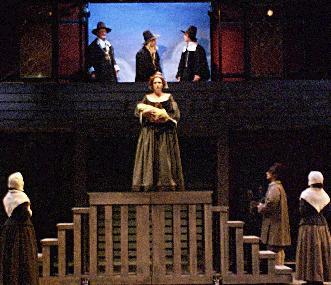SEARCH CurtainUp
REVIEWS
FEATURES
NEWS (Etcetera)
ADDRESS BOOKS
Broadway
Off-Broadway
BOOKS and CDs
OTHER PLACES
Berkshires
London
Los Angeles
Philadelphia
Elsewhere
QUOTES
TKTS
LETTERS TO EDITOR
FILM
LINKS
MISCELLANEOUS
Free Updates
Masthead
NYC Weather
 Berkshire Review
Berkshire ReviewThe Scarlet Letter
|
Hawthorne's brilliant insight -- he is writing now in 1850, at the time of Brook Farm and the Abolitionist Feminists -- was that the very qualities that render a woman able to see the iron framework of society also disable her as an adulterated woman. He captures it all in the letter A, which, as the story explains, means Able as well as Adultery. The central theme in my book, The Birth of Pleasure, is the tension between love and patriarchy. This is also the theme of The Scarlet Letter.
---Carol Gilligan |

The Scarlet Letter at the Founders' Theatre
(Photo: Kevin Sprague)
|
Contrary to what you might expect from Gilligan, this is not an edgy, modernized and extensively rewritten feminist version of the original. In fact, having re-read the novel for her recently published book , The Birth of Pleasure, Dr. Gilligan recognized Hawthorne as a man ahead of his time who was surrounded by many strong women. She believed that Hester Prynne was a heroine who could speak to modern audiences within the framework of Hawthorne's novel and through his words. He had after all created a woman who withstood pressure and didn't merely survive seven years of the shunned life forced on her by a harsh patriarchal society but in the process gained a clearer vision of morality than her righteous tormentors.
And so, what Dr. Gilligan and Tina Packer, her long-time friend and the play's director, have wrought is a fairly straightforward dramatization rather than a riff on the letter A's symbolism -- shades of Pulitzer Prize winner Suzann-Lori Parks' 1999 play In the Blood (see link below) and her forthcoming variation on the same symbol with the in-your-face title, Fucking A.
Gilligan's script, while hardly an audacious departure from the novel, does have some interesting added elements; for example, she has written a God-Is-love sermon for the Reverend Dimmesdale to deliver (it's merely talked about in the novel). She has also built up the relationship between Dimmesdale and Hester with a seven years later love scene to reinforce the relationship. Though the lovers remain star-crossed. there is an upbeat ending by virtue of a tacked on interpretive epilogue for the illegitimate baby Pearl as a grown woman.
The new play, like the novel, takes us through more than a dozen episodes over a period of seven years. It begins with Hester Prynne (Jennie Israel) , a young married woman whose husband is presumed dead, standing on a town scaffold -- the baby whose father she won't name in her arms, and the letter "A" for adulteress emblazoned on her bodice. To make matters worse, Hester's husband (Michael Hammond) shows up but insists that she lets him remain incognito and, true to his assumed name, Roger Chillingworth, he concocts a chilling plot to smoke out and punish her fellow "sinner." All signs point to the also aptly named young Reverend Arthur Dimmesdale (Jason Asprey) who falls ready victim to Chillingworth's strategy of what today would be called mind control games. While Arthur is doomed to collapse on the very scaffold where Hester stood firm and proud seven years earlier, his paramour and finally acknowledged daughter Pearl (Kate Holland) do leave Boston for a less oppressive life.
The production is, as usual, handsomely mounted with numerous hallmarks of the Company's Shakespeare plays in this two-year-old theater. Nine actors, several playing multiple roles, are called upon to create the aura of Boston in the mid-17th century. The scenic effects rely on a single dominant prop (in this case two wooden stairways that lock together to form the scaffold and slide open to serve various other scenic purposes). As always, the platform at the rear of the stage is used to good effect and the aisles are used to give the audience a sense of being inside Hawthorne's world.
Jennie Israel is an impressive Hester. The ensemble work is generally fine even though Ms. Packer has allowed choreographer Susan Dibble's stylized movement of the townspeople across the stage to become tiresomely repetitious. There are also some major casting missteps. Jason Asprey's Dimmesdale simply does not convey the depth of conflicted feelings the role calls for. Then there's the matter of little Pearl played by a decidedly grown-up Kate Holland. In trying to focus on Pearl as a bridge-character between Dimmesdale and Hester, Gilligan and Packer have allowed her to appear more imbecilic than insightful. Ms. Holland does her best with this impossibly difficult part but it needs, if not a talented youngster, at least a more petite and more convincingly child-like actress.
As long as I'm nitpicking, the play is rather awkwardly divided into a ten-scene, hour and a half long first act, followed by a four-scene second act lasting just half an hour. The simplest solution for better balance would be to heavily apply a blue pencil to the first act's choreographed elements, or revise the script to allow for an earlier break..
Like the recent revival of Arthur Miller's The Crucible, this production is a thought-provoking second look at a work that shows the irony of life among a group of America's early settlers -- people who came to this country to escape religious oppression, but then put themselves into the prison of their narrow-minded, sin-obsessed beliefs. If I were a high school English teacher within bus distance to the Founders' Theatre, I'd jump at this opportunity to show my students the process of moving an old classic from page to stage.
LINKS
In the Blood
The Crucible
The Scarlet Letter as adapted by Dr. Carol Gilligan
To read or download The Scarlet Letter on line from go here
| The Scarlet Letter Nathaniel Hawthorne's Novel, adapted by Dr. Carol Gilligan Directed by Tina Packer Cast:Jason Asprey as Dimmesdale, Jonathan Croy as Governor Bellingham/chorus, Dave Demke as Reverend Wilson/chorus, Mary Guzzy as Mistress Hibbard/chorus, Michael Hammond as Chillingworth, Kate Holland as Pearl, Jennie Israel as Hester Pryne, Tom Wells as townsperson/chorus, and Catherine Taylor-Williams as townsperson/chorus. Scenic Design: Judy Gailen Costumes: Harry Johnson Lights:Karen Perlow Sound: Jason Fitzgerald Choreographer: Susan Dibble Shakespeare & Company's 473-seat Founders' Theatre, Lenox, MA (413) 637-3353 or www.shakespeare.org. Performances: 9/13/02-11/03/02; opening 9/14/02 Friday and Saturday night at 7:30 and Sunday at 2:00 pm, plus seven student matinees at 10:00 a.m. Fridays. Special packages for student matinees, senior, and group rates are available through the Group Tour Office at (413) 637-1199 ext.132 or groupsales@shakespeare.org. Tickets: $10.00 - $45.00 (with senior/student/group rates available); Running time: 2 hours, plus one intermission Reviewed by Elyse Sommerbased on September 14th performance |



6,500 Comparative Phrases including 800 Shakespearean Metaphors by CurtainUp's editor.
Click image to buy.
Go here for details and larger image.
